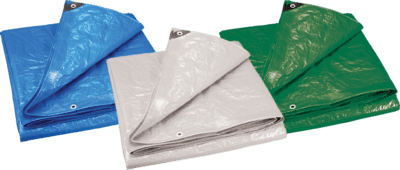Look, we know our claim to fame is keeping 18-wheelers rolling safely down the highway with custom retractable tarp systems tough enough to laugh in the face of a blizzard. But when your name is Verduyn Tarps, people naturally expect you to be tarp experts in all situations — not just ones that involve flatbeds and freight.
So, in the spirit of living up to our name (and maybe saving you a soggy outcome), we’re stepping off the highway for a moment. Whether you’re a green-thumb gardener battling surprise rain showers, a backyard DIYer, or just someone who’s ever thought, “Hmm, I bet a tarp could fix that,” — this one’s for you.
North Americans know all too well that our climate is subject to change throughout the year. Along with that change comes a need to adapt and more importantly, prepare.
With fall starting to show its true colours, preparing for winter is a reality for many North Americans. A common practice this time of year is the dismantling of gardens in preparation for the following spring.
Here at Verduyn Tarps, we have you covered… literally.
Preparation of gardens before the winter has a wide variety of benefits for the following growing season:
Season Extension: Tarping a garden can extend the season of growing by reducing the volume of residual moisture left over from winter. This allows you to get a jumpstart in the spring.
Specialty Crop Production: Many crops that North Americans love are not native to this region. Tropical or warmer climate vegetation needs higher temperature soils to thrive. By cutting small slits in a blanketing tarp the sprouts are able to receive the moisture and sunlight to grow, whilst the tarp acts as a green house to keep the soil and roots warm.
Crop Residue Cover: For years farmers and organic gardeners have come up with different approaches and cost-effective ways to maximize what they already have, to produce the best results. An often-successful practice is performed by creating a self-sufficient composter right in the garden bed. Agriculture professionals will utilize waste such as yard clippings and discarded fruits and vegetables placed under a tarp cover for the winter. Over the winter months the Tarp acts a composter lid allowing for the waste to break down into bio waste that adds a variety of helpful nutrients for spring.
Reduced Irrigation: A covered soil bed away from wind and direct sunlight maintains productive moisture longer resulting in less work come spring.
While professionals utilize these practices on a large scale every year, home owners and hobby farmers can take advantage of these methods with the same results.
We want to help. Our line of Utility Tarps boast a large variety of size and weight to fit every need.
Economy Tarp: Ranging in size from 16’ x 20’ through 40’ x 60’, this 2.4 oz Tarp is lightweight and easy to maneuver while offering a waterproof polyethylene coating.
Ice Rink Tarp: As the name suggests these tarps are often used as the lining bed for backyard rinks. With sizes that range from 16’ x 20’ to 50’ x 100’. This 3.5 oz Tarp boasts an ability to perform at extreme low temperatures. Come pick up today while limited supplies last.
Heavy Duty Utility Tarp: At 6 oz in weight the HD Utility Tarp is the heaviest of our Utility Tarps. While Green on one side and white on the other this tarp provides the most durable performance in sizes ranging from 20’ x 30’ to 50’ x 100’.
What sets us apart?
Here at Verduyn we do our research. When looking for what you the consumer wants in a Utility tarp we found the most frequent criticism was the tarps lifespan. Often this problem is directly related to rusting grommets and weak perimeter reinforcements.
At Verduyn we have the solution. All of our Utility Tarps have a rope reinforced hem around the perimeter with rust resistant aluminum grommets approximately every 36". Adding to the longevity and strength these tarps are mildew proof to avoid any rotting throughout the winter use.
Why wait and struggle with your garden come spring? Come visit one of our four North American locations today and let us help you grow.
YEAR-ROUND TARP USES FOR THE BACKYARD GARDENER AND MORE
Tarps are not just for winter! We know that tarps are extremely useful for Canadian winters, offering protection and insulation in various ways, such as garden protection. Covering soil with a tarp helps retain warmth and moisture, preventing frost damage and preparing for early spring planting. Tarps also shield firewood from snow and rain, keeping it dry and ready for use. Some homeowners use tarps to collect and move snow more efficiently. They are also used to protect your cars and other equipment from ice buildup and harsh winter weather. Moreover, tarps can also serve as emergency shelters during a winter storm.
Spring: Renewal & Preparation
Let us explore how tarps can be useful during other seasons. Spring in Canada is a season of renewal, and tarps become surprisingly handy allies during this time. Here’s how they shine when the snow melts and the ground thaws:
- Garden Preparations and Weed Control
Tarps are perfect for occultation, a method where you cover garden beds to smother weeds and warm the soil before planting. This passive technique helps kill off weed seeds and old plant debris without disturbing the soil. - Compost Management
Spring rain can turn compost piles into soggy messes. Covering them with a tarp helps regulate moisture and trap heat, which could speed up decomposition and keep soil nutrients intact. - Home Maintenance
Whether you're staining a deck or painting the shed, tarps protect surfaces from spills and splatters. They also catch debris during gutter cleaning or roof repairs, making cleanup a breeze. - Outdoor Adventure
Planning a picnic or camping trip? A tarp makes a great waterproof groundsheet or emergency shelter. It’s easy to clean and keeps you dry even on damp spring grass. - Construction and DIY Projects
Spring is prime time for building repairs. Tarps can shield tools, lumber, and work areas from unpredictable rain or lingering snow.
Summer: Sun, Storms & Play
Summer in Canada brings sunshine, storms, and everything in between—perfect conditions for putting tarps to work! Here are some clever and practical ways people use tarps during warmer months:
- Shade and Shelter
Tarps make excellent makeshift canopies for patios, gardens, or campsites. Whether strung between trees or mounted on poles, they offer quick relief from the sun or sudden rain. - Slip ‘n Slide Fun
This is a classic summer favorite for the kids (and the young at heart). Lay out a tarp, add water and a bit of soap, and you’ve got an instant backyard water slide for your kids to enjoy. - Protecting Outdoor Furniture
UV rays can fade and crack patio furniture. Covering them with tarps when not in use helps extend their life and keeps them clean. - Garden and Landscaping Projects
You can use tarps to haul soil, mulch, or yard waste. They are also great for covering garden beds to suppress weeds or protect seedlings from heavy rain. - Pool and Pond Covers
Tarps can help keep debris out of pools and ponds, especially during windy days. They can also serve as liners for temporary water features or rainwater diversion. - Picnic and Camping
During picnics or camping, you can lay one under your tent or blanket to keep things dry and clean. Tarps are easy to shake off and pack up.
Fall: Seasonal Shifts & Protection
Fall in Canada is known for its mood swings. One day you are basking in sunshine, the next you’re digging out your scarf and umbrella. Tarps become indispensable tools during this time. They can be used for a variety of purposes.
- Yard Cleanup and Landscaping
Falling leaves, trimmed branches, and garden debris? Tarps make it easy to gather and haul everything in one go. Poly tarps and mesh tarps are particularly useful for this type of work. - Protecting Outdoor Furniture and Equipment
As patios and grills get packed away, waterproof tarps shield them from rain, frost, and early snow. Covering your equipment will help extend the life of your gear through the off-season. - Farming Use
Silage tarps are widely used to cover fields before planting, killing weeds naturally and warming soil for better germination. Farmers also use tarps to cover hay bales and animal feed from rain and snow, which is helpful in preventing spoilage. Some farmers also use tarps to cover harvested produce for easier and safer storage.
Tarps are the unsung heroes of every season in Canada. Whether it’s shielding crops in spring, providing shade in summer, protecting equipment in fall, or braving the winter storms, tarps prove their versatility year-round.
With the right material—polyethylene, canvas, vinyl, or mesh—they adapt to changing weather and countless practical uses. So, no matter the season, there’s always a way to put a good tarp to work!
Need help choosing the perfect tarp for a specific job? We have got you covered - literally!
Note: This expanded blog post incorporates information from the original article and adds detailed insights into equipment, securement methods, and considerations specific to Canadian truckers. For further information or to purchase equipment, please visit Verduyn Tarps.


